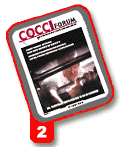Combating Resistance
Vaccination seeds houses with oocysts that are sensitive to commonly used in-feed coccidiostats
Poultry producers confronting
resistance to in-feed coccidiostats
can minimize the problem
by incorporating coccidiosis vaccination
into their management plan, says
poultry veterinarian Dr. Linnea J.
Newman.
Continuous and long-term use of infeed
ionophore coccidiostats has resulted
in resistance and less effective control
of coccidiosis, which is caused by
protozoan parasites of the Eimeria
genus, says Newman, a consulting veterinarian
for Schering-Plough Animal
Health. Resistance results in impaired
performance, particularly poor weight
gain.
However, rotating coccidiosis vaccination
with the in-feed products
"seeds" the houses with oocysts that
are more sensitive to the in-feed treatment,
she says.
Changes Oocyst Population
Coccivac-B, Newman explains, is a live
vaccine produced with oocysts that
were isolated before currently used
coccidiostats were even developed.
Consequently, birds that receive this
vaccine shed oocysts that are sensitive
to the in-feed coccidiostats widely used
today by poultry producers.
"In other words, the vaccine can be
used to change coccidiostat-resistant
populations into coccidiostat-sensitive
populations," she says. "The oocysts
that result from vaccination, in fact, are
extremely sensitive to both chemicals
and ionophores, yet they are not as virulent
as some of today's coccidiostatresistant
field isolates."
Clear Evidence
As evidence, Newman points to
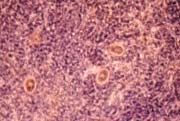 Eimeria maxima
|
She also cites trials conducted by Dr. Harry D. Danforth of the USDA (see feature on page 6), which further demonstrate that vaccinating with Coccivac-B renews the sensitivity of an on-farm coccidial population to the ionophore salinomycin, the most widely used coccidiostat in the United States.
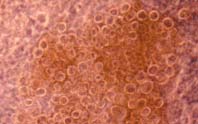 Eimeria acervulina
|
Next, sensitivity to salinomycin was tested. One group of specific- pathogen-free (SPF) birds was challenged with oocysts from the vaccinated houses, and another group of SPF birds was challenged with oocysts from the ionophore-treated houses. During the challenge, all birds received 60 ppm of salinomycin.
Weight Gain Improved
Comparison of the two groups revealed much better weight gain in the birds
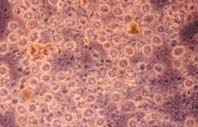 Eimeria tenella
|
More recent studies by Danforth indicate that vaccination can not only restore the sensitivity of oocysts to coccidiostats, but that it changes the composition of mixed species oocysts in the field and their ability to cause intestinal damage, Newman says.
For instance, an aggressive strain of Eimeria tenella and a moderately pathogenic E. maxima were isolated from litter samples collected from a farm at a large broiler integrator. After the samples were collected, a new flock was
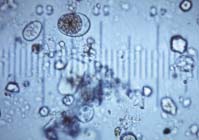 Mixed-species oocysts
|
The mixed-species oocyst population from each sample was isolated and used to challenge 10-day-old SPF test birds fed nonmedicated or salinomycin- medicated feed. Six days after the challenge, the birds were weighed and intestinal lesions were recorded. "Following vaccination with Coccivac-B, the aggressive E. tenella population had virtually disappeared," Newman says. Before vaccination, the E. tenella was considered very aggressive and created high lesion scores, even in salinomycin-medicated birds. It should also be noted that 3-Nitro (arsenelic acid) had to be used routinely to augment the ability of ionophore coccidiostats to control E. tenella, she says.
Lesion Scores Improve
After immunization, lesion
scores for the middle and
upper intestine due to E.
maxima and E. acervulina
had improved in salinomycin-
medicated birds,
which indicates that vaccination
had an impact on
these species of Eimeria
and that each species had
improved sensitivity to salinomycin
after vaccination.
Coccidiosis vaccination can not only
be rotated with coccidiostats, it can be
an alternative to these in-feed products,
Newman says.
Vaccine Fosters Natural ImmunityIn-feed coccidiostats prevent coccidiosis by disrupting the parasite's life cycle, but vaccination enables chicks to develop natural immunity to coccidiosis infection, Dr. Linnea J. Newman explains.Immunity develops when birds are exposed to infected oocysts passed in droppings. "It takes about two or three cycles of mild infection to provide immunity adequate enough to protect chicks from later field exposure to coccidia," she says. Vaccination is more likely to be successful today than ever before because better methods of administration have been developed. For example, spray cabinet administration on hatching day helps ensure the vaccine is administered evenly to chicks, which in turn helps development of immunity in a flock and protect against coccidiosis outbreaks, she says. |
Source: CocciForum Issue No.2, Schering-Plough Animal Health.








